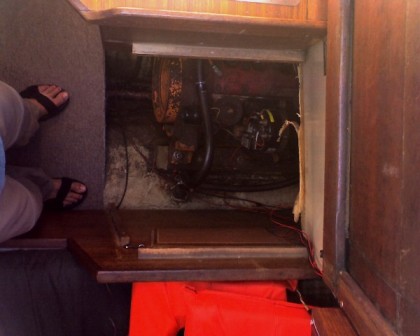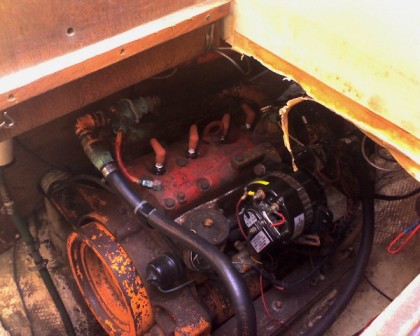|
| Pulling Palmer P-60 from boat |
| Author |
Message |
    
ChipG
Visitor
| | Posted on Tuesday, September 01, 2009 - 08:26 pm: | 




|
Greetings once again. Hope your summer went well.
I am ready to pull my P-60 in order to access the valve covers and need some advice with regard to approach. Looks like there are four studs coming from the stringers over which the motor mount points sit. Each of them has a nut holding the motor in place. Additionally, I see the place where the transmission attaches to the shaft with a coupler. In order to remove the engine without damaging shaft seals, bending shaft, or any other damage, what is the best approach to take?
As always, your comments are greatly appreciated |
    
miro forest
Senior Member
Username: miro
Post Number: 391
Registered: 11-2001

| | Posted on Wednesday, September 02, 2009 - 08:49 am: | 




|
If I were doing this, I'd probably take the engine and transmission out as a single unit.
The alignment of engine and transmission is a tougher job than aligning the shaft to the transmission.
miro |
    
Richard A. Day Jr.
Senior Member
Username: richardday
Post Number: 795
Registered: 11-2003

| | Posted on Wednesday, September 02, 2009 - 09:12 am: | 




|
I agree with Miro. If you were to separate the transmission from the engine block you would have to pump out the oil in the transmission as it is separate from the oil in the pan of the engine.
You probably would have to make a new gasket for the joint between the transmission and the engine.
To seperate the coupling is a simple matter of removing the cap screws holding the two halfs together. Some couplings have a centering disk which insures the two halfs precisely center with one another. Don't lose it in the bilge. Mark the coupling with a center punch or sharpie so you put the coupling back in the original mating relationship. When you put the engine back and are ready to connect the coupling to the engine you don't know how much removing the engine from the beds may have changed alighment so take three strips of paper and put them between the two halves of the coupling. Push the halfs together and all should remain in the coupling if the engine is corretly oriented to the shaft. If one or more fall out then you simply sometimes tediously insert shims between the engine bed and the the engine. Some installation have adjustable mounts for the engine which makes the job a little easier but whatever you do don't ignore misalignment between
the shaft and the engine. |
    
ChipG
Visitor
| | Posted on Saturday, September 05, 2009 - 07:27 pm: | 




|
Thanks Richard and Miro. I think I may have miscommunicated my intended question. I think it is really basic... I am not sure all the things I need to disconnect in order to remove the engine and where to find all the bolts/nuts that will need to be removed. Here is the list I have so far. Does it seem like I am missing anything?
1. 4 nuts holding the mounting bracket of the engine itself to the four studs coming from the engine stringers (2 port / 2 starboard)
2. Shaft Coupling
3. Fuel line
4. Electrical wires to battery switch and starter switch
5. Exhaust pipe
Also wondering if there is any "well known" trick to deal with the alignment of the lifting lug problem. The lifting lug is slight starboard of the opening where I could drop a block & tackle rig or crane cable so I cannot directly lift the whole motor without risking the cable causing some damage to the wood and fiberglass when it initially goes taught to lift the engine. I figure the engine would swing over on it's own once it is lifted off the mounting lugs but what about the pressure on the crane cable or line from the block&tackle during the initial lift? This is a little hard to describe but I hope I have made my question clear. I have included a photo in an attempt to illustrate the issue.
Thanks again!

 |
    
Richard A. Day Jr.
Senior Member
Username: richardday
Post Number: 797
Registered: 11-2003

| | Posted on Saturday, September 05, 2009 - 07:44 pm: | 




|
Some boatyards have an L shape lifting piece which is used for problems like yours. It is simply hooked on the crane hook and rugged enough to handle the load. |
|
|
|


|


